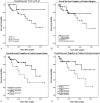Update on Surgical Outcomes of Lateral Temporal Bone Resection for Ear and Temporal Bone Malignancies
- PMID: 28180041
- PMCID: PMC5288114
- DOI: 10.1055/s-0036-1584310
Update on Surgical Outcomes of Lateral Temporal Bone Resection for Ear and Temporal Bone Malignancies
Abstract
Objectives Review outcomes of lateral temporal bone resections for ear and temporal bone malignancy. Design, Setting, and Participants Retrospective review of all lateral temporal bone resections performed from 2008 to 2015 at a single tertiary care center. Main Outcome Measures Patient demographics, perioperative variables, overall survival, disease-free survival (DFS), and comparison of Kaplan-Meier curves. Results Overall, 56 patients were identified with a mean follow-up period of 2.3 ± 1.8 years. The predominant histopathologic diagnosis was squamous cell carcinoma (SCC, 54%), followed by salivary gland tumors (18%), and basal cell carcinoma (9%). Tumor stages were T1-T2 in 23%, T3-T4 in 73%, and two unknown primary lesions. Mean overall survival was 4.6 ± 0.4 years. Comparison of tumors with and without lymph node involvement or perineural invasion approached statistical significance for overall survival (p = 0.07 and 0.06, respectively). DFS was 2.5 ± 0.3 years. Stratification by lymph node status had a statistically significant difference in DFS (p = 0.03). Subgroup analysis of SCC patients did not reveal significant differences. Conclusions Based on our cohort, most patients with temporal bone malignancies present with advanced disease, making it difficult to achieve negative margins. Overall, lymph node status was the strongest predictor of survival in this group.
Keywords: cancer; lateral temporal bone resection; malignancy; outcomes.
Conflict of interest statement
Figures



References
-
- Crabtree J A, Britton B H, Pierce M K. Carcinoma of the external auditory canal. Laryngoscope. 1976;86(3):405–415. - PubMed
-
- Testa J R, Fukuda Y, Kowalski L P. Prognostic factors in carcinoma of the external auditory canal. Arch Otolaryngol Head Neck Surg. 1997;123(7):720–724. - PubMed
-
- O'Connor A, Behan L, Toner M, Kinsella J, Beausang E, Timon C. Evaluating the outcomes of temporal bone resection in metastatic cutaneous head and neck malignancies: 13-year review. J Laryngol Otol. 2015;129(10):964–969. - PubMed
-
- Bacciu A, Clemente I A, Piccirillo E, Ferrari S, Sanna M. Guidelines for treating temporal bone carcinoma based on long-term outcomes. Otol Neurotol. 2013;34(5):898–907. - PubMed
-
- Parsons H, Lewis J S. Subtotal resection of the temporal bone for cancer of the ear. Cancer. 1954;7(5):995–1001. - PubMed
LinkOut - more resources
Full Text Sources
Other Literature Sources
Research Materials

